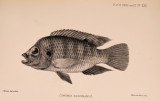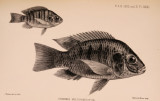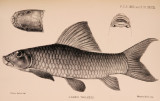| OCR Text |
Show 304 LT.-COL. J. M. FAWCETT OK [Nov. 4, 3. On the Transformations of Papilio dardanus Brown and Philampelus megcera ; and on two new Species of South-African Heterocera. By Lt.-Col. J. M a l c o lm F a w c e t t . [Received August 8, 1902.] (Plate X X V I.1) 1. P a p il io d a r d a n u s . (Plate X X V I. figs. 6, 7, larva; 8, 9, 10, pupa ; 11, head of larva ; 12, 13, female forms of imago bred.) Papilio dardanus Brown, 111. Zool. p. 52, t. 22 (1776). cf - merope Cramer, Pap. Exot. vol. ii. p. 87, pi. cli. figs. A, B (1777). 5 = cenea Stoll, Suppl. Cramer, p. 134, pi. xxix. figs 1, 1 a (1791). § = a variety of hippocoon Fabricius, Ent. Syst. iii. 1, p. 38 (1793). D e scrip t ion .-Larva, early stage. Head greyish green, body dark chocolate-brown dorsally, abdomen, legs and claspers greyish green; broad white lateral stripes above the spiracles, meeting across the back on the 2nd, 5th and 6th, and 10th somites. On 1st somite a pair of long filamentous horns or tentacles minutely serrated with very short bristles, a pair of very short horns on 11th somite, and on the 12th somite a pair of similar horns to those on 1st somite but shorter, all greyish green in colour. The larva presents, in this stage, a great resemblance to the droppings of a small bird. Final stage. Head green, body pale bluish green dorsally, abdomen, legs and claspers greyish white. On first somite a pair of short yellow tubercles from between which the Y-like organ (which is crimson paling to grey at the tips) is protruded when the larva is alarmed. On anal somite a pair of paler yellow tubercles ; on 3rd somite a pair of black " eye-spots " surrounded by a white iris, subdorsally; a dorsal series of pale blue spots on 3rd to 6th somites, one on each somite. A yellowish-white subspiracular line from 4th somite to the tubercles at the anal extremity; spiracles reddish. The larva in this stage is very limaciform, the divisions of the somites being very indistinct, and the body being very smooth and velvety. Feeds on Toddalia lanceolata Lamarck, nat. ord. Rutacese. The larva feeds very low down on the plant, almost on the ground. It is always on the old leaves, and is very difficult to find. Pupa. Pale yellowish green dorsally, darker green along the abdomen and wing-cases, and being almost flat and much expanded laterally, it looks exactly like one of the leaves of the food-plant. The palpi-covers, instead of being divergent as in other species of Papilio, converge to form a point, thus simulating the 1 For explanation of tho Plate, see p. 307. |
































































































































































































































































































































